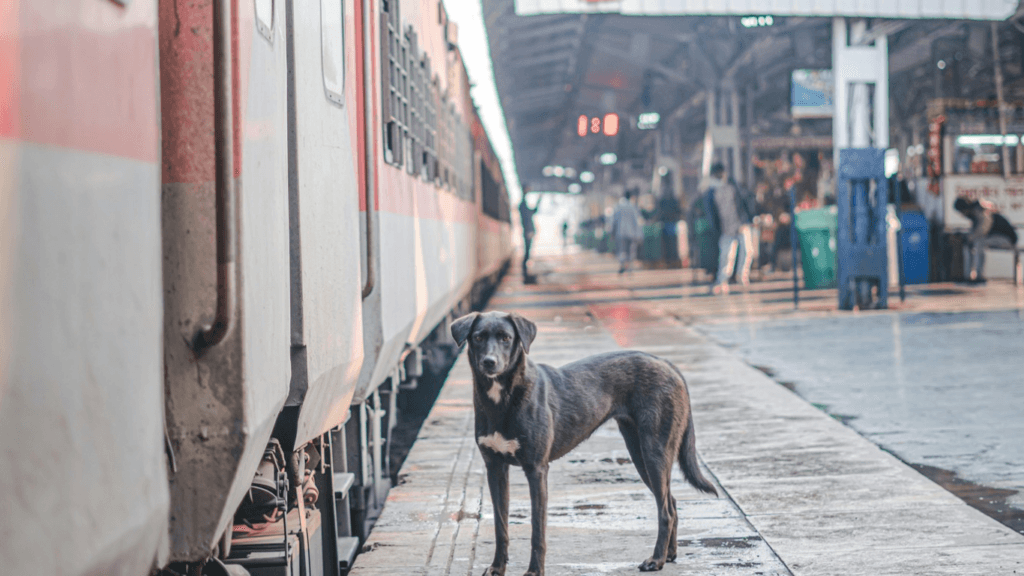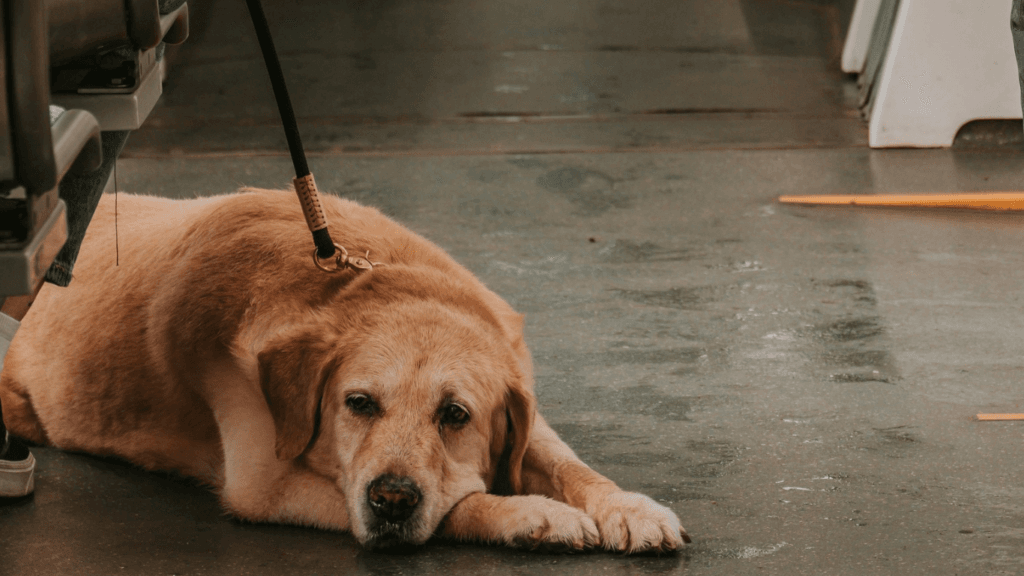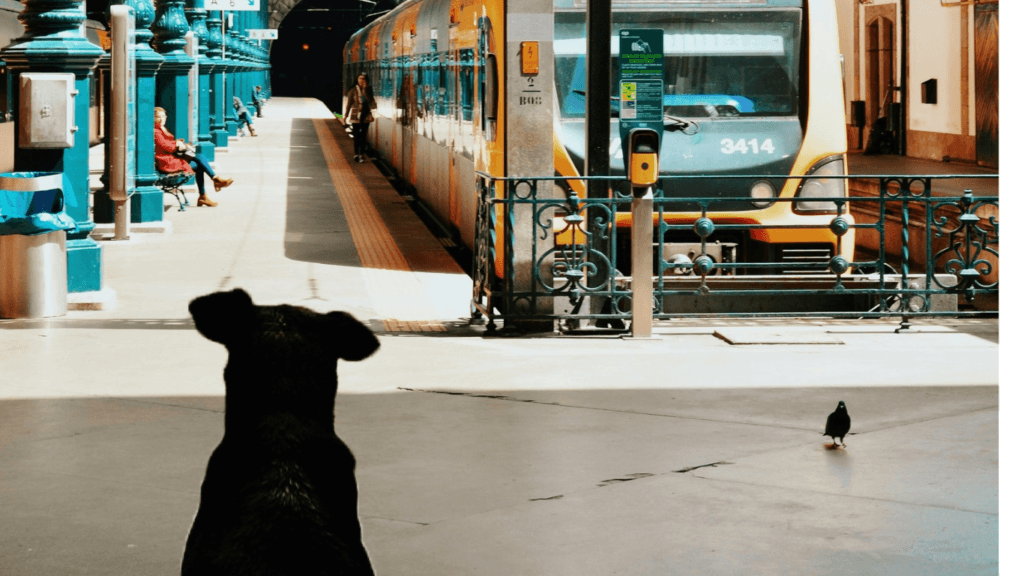Table of Contents
Introduction
Picture this: you’re planning a scenic train journey, and your furry best friend is wagging their tail, begging to join the adventure. But wait—can dogs actually ride trains, or is this just a far-fetched dream? As more pet owners embrace their companions as family, the idea of travelling with dogs on trains has surged in popularity.
Gone are the days when pets were left behind with sitters; today, they’re co-pilots on everything from weekend getaways to cross-country trips. But before you grab that leash and hop aboard, let’s untangle the facts from the myths.
Train travel with pets isn’t just a quirky trend—it’s a movement fueled by love for our four-legged companions. However, the big question remains: Can I travel with dog in train? The answer is a cautious yes, but with a twist. While many railway services worldwide (and in India specifically) are becoming increasingly pet-friendly, the rules aren’t as straightforward as buying a ticket and claiming a window seat. From leash policies and carrier requirements to breed restrictions and paperwork, there’s a lot to unpack.
This blog isn’t just about saying “yes” or “no.” It’s your go-to guide for navigating the how. We’ll dive into railway policies, share pro tips for stress-free journeys, and even explore real-life stories of pet parents who’ve mastered the art of train travel with their pups. Whether you’re a first-time traveller or a seasoned explorer, you’ll discover how to prep your dog for the clatter of wheels, the hum of conversations, and the occasional whistle-stop chaos.
But here’s the truth: travelling with a dog isn’t just about rules—it’s about responsibility. A happy journey depends on your pup’s comfort, your fellow passengers’ peace, and your awareness of the dos and don’ts. So, before you book those tickets, let’s ensure you’re armed with everything you need to turn “Can I?” into “We did!”

Train Policies
So, you’re ready to hit the rails with your pup—but hold that thought! Before packing their favorite chew toy, let’s decode the *real* rules of train travel for pets. Indian Railways, along with private operators like Vande Bharat, has quietly rolled out pet-friendly policies, but they come with a few “paw-sitive” conditions. Here’s the scoop:
Indian Railways allows dogs on board, but size matters. For small dogs (think Dachshunds or Pugs), they must travel in secure, well-ventilated carriers that fit under your seat or in the luggage area.
No window seats for Fido, sadly! Big breeds like Labradors or German Shepherds? They’re welcome too, but with stricter rules: they need a muzzle, a leash, and must be booked in second-class compartments (no AC coaches). Oh, and you’ll pay a “pet ticket”—₹10–30 for small dogs and up to ₹60 for larger ones. Private trains, like Vande Bharat, often mirror these rules but may require advance notice or limit pets to specific coaches.
Now, the golden question: Can your dog sit beside you? Only if they’re in a carrier. Loose pets aren’t allowed, even if they’re the size of a teacup. Leashes are non-negotiable for walks during halts, and cleanliness is key—bring waste bags or face glares from fellow passengers.
Here’s the kicker: documentation is your best friend. A vet’s health certificate (Form D from Indian Railways) is mandatory, proving vaccinations and fitness to travel. No paperwork? No boarding.
But what about luxury trains or tourist routes? Some, like the Palace on Wheels, outright ban pets, while others may allow them with hefty deposits. Always call ahead—don’t rely on websites!
Pro tip: Big dogs often face more scrutiny, so arrive early to avoid last-minute chaos. And if your pup’s a nervous traveller, practice short train rides first.
Bottom line? Trains can be pet-friendly, but it’s a game of rules. Follow them, and you’ll both enjoy the journey. Break them, and you might end up stranded at the station with a very disappointed doggo.
Pre-Travel Preparations
Travelling with your dog on a train can be a wonderful experience, but proper preparation is essential to ensure a smooth and stress-free journey. Whether it’s a short trip or a long-distance journey, your pet’s comfort and safety should be your top priority. Here’s what you need to do before boarding the train with your furry friend.
Importance of Vet Checkups and Vaccinations
Before you travel, schedule a visit to the vet to ensure your dog is healthy and fit for the journey. Some trains require proof of vaccinations, so make sure your pet’s records are up to date. A general health checkup can also help detect any issues that could make travel uncomfortable for your dog. If your pet has anxiety or motion sickness, consult your vet for suitable remedies.
Packing List: Essentials for Your Dog
Packing the right items can make your journey much easier. Carry enough water to keep your dog hydrated, as dehydration can cause discomfort during travel. Pack sufficient food and treats, especially if the journey is long. Don’t forget waste bags to clean up after your pet and ensure a hygienic environment. A familiar comfort toy or blanket can help your dog feel safe and relaxed in an unfamiliar setting.
Getting Used to the Noise and Crowd of the Train
Trains can be noisy and crowded, which may overwhelm your dog. To prepare, take your pet on short trips in busy environments, such as parks or public transport, to help them adjust to new sounds and people. Playing train sounds at home at a low volume and gradually increasing it can also help desensitize them. If your dog is particularly anxious, consider a calming vest or natural anxiety remedies.

By taking these steps before your journey, you can make train travel a pleasant experience for both you and your dog. Proper planning ensures that your furry companion stays comfortable, happy, and stress-free throughout the trip.
Pre-Travel Preparations
Travelling with your dog on a train can be a great experience if you prepare properly. A little planning will ensure that your pet stays safe, comfortable, and stress-free throughout the journey. Here are some essential steps to take before you board the train with your furry friend.
Vet Checkups and Vaccinations
Before travelling, it’s crucial to visit a veterinarian for a health checkup. A fit and healthy dog will have a much smoother journey. Make sure all vaccinations are up to date, as some train services may require proof of vaccination. If your dog suffers from anxiety or motion sickness, consult your vet for suitable remedies. A health certificate from the vet may also be necessary, depending on train policies.
Packing Essentials
Packing the right items will make the trip more comfortable for your pet. Bring enough food and water to last the entire journey. A collapsible water bowl is a convenient option. Don’t forget waste bags for cleaning up after your dog. A familiar comfort toy or blanket can help reduce anxiety and make the training environment feel more like home. If the journey is long, consider carrying some treats to keep your dog engaged.
Familiarizing Your Dog with Train Travel
Trains can be noisy and crowded, which might overwhelm your pet. To help them adjust, expose them to similar environments before the trip. Take them to a busy park or play train sounds at home to get them used to the noise. If your dog is not used to being in a crate or carrier, introduce it gradually so they feel comfortable staying inside during the journey.
Documentation
Check the train company’s pet policy beforehand. Some trains require advance booking for pets, while others may have restrictions on size or breed. Carry all necessary documents, including vaccination records, an ID tag with your contact details, and any required permits. Having these ready will make the boarding process smoother and prevent last-minute issues.
With the right preparation, travelling with your dog by train can be a hassle-free and enjoyable experience for both of you!
Quick Answer to Your Most Pressing Questions
Traveling with a pet can be exciting but also challenging, especially when it comes to train journeys. Many pet owners wonder, Can I travel with my dog on a train? The answer depends on the train service, route, and country-specific regulations. Some trains allow small pets inside passenger coaches, while others require pets to travel in designated compartments or luggage vans.

Train travel with pets can be a wonderful experience if planned properly. Many pet owners want to take their furry friends along, but the rules and policies can be confusing. Here’s a quick guide to help you understand whether pets are allowed, how to book their journey, and tips for a smooth trip.
Are Pets Allowed in All Trains?
No, not all trains allow pets. In many countries, including the USA and India, different rules apply depending on the train service. Some high-speed and luxury trains prohibit pets (except for service animals), while long-distance and regular trains may allow them under specific conditions. Always check with the train operator before booking to avoid last-minute surprises.
Extra Charges or Booking Process?
Most train services require you to book a pet ticket separately. Some important points to consider:
USA (Amtrak & Others)
Small pets (dogs and cats under 20 lbs) are allowed on many Amtrak routes for an additional fee (around $26). They must be in a pet carrier that fits under your seat. Larger dogs are usually not allowed unless they are service animals.
India (Indian Railways)
Pets can travel in First Class AC compartments with prior booking. You need to contact the Parcel Office to book a pet ticket. If you’re traveling in other classes, pets may have to be transported in the luggage van. Charges depend on the pet’s weight and the train route.
For other countries, policies vary, so it’s best to check with the specific railway service.
Tips for Long-Distance Travel
Book in Advance
Since pet accommodations are limited, secure your pet’s ticket as early as possible.
Use a Comfortable Carrier
If your pet is small, ensure their carrier is well-ventilated and cozy. For larger dogs, check if they need a leash, muzzle, or crate.
Pack Essentials
Bring food, water, a leash, a waste disposal bag, and a favorite toy to keep your pet calm.
Take Breaks When Possible
If the train allows, take short breaks to let your dog stretch and relieve itself.
Train Your Pet Beforehand
If your pet isn’t used to confined spaces, introduce them to a carrier or short train rides before the journey.
By planning ahead and following the right procedures, you and your furry friend can have a safe and enjoyable train journey!
Heading: Legal & Health Aspects
Traveling with your dog by train can be a rewarding experience, but it requires careful planning to ensure compliance with legal regulations and safeguard your pet’s health. Whether you’re embarking on a short trip or a cross-country journey, understanding the requirements and preparing for emergencies will help create a stress-free adventure for both you and your furry companion.

Necessary Documents
Veterinary Health Certificate
A mandatory document issued by a licensed veterinarian, typically within 24 hours of travel, confirming your dog is healthy, vaccinated, and free of contagious diseases. This certificate must include your pet’s microchip number, vaccination records (especially rabies), and details like breed and age . In China, additional steps may apply, such as obtaining an animal quarantine certificate and a cage disinfection certificate 2–3 days before departure .
Vaccination Records
Ensure your dog’s rabies vaccination is up-to-date and administered at least 30 days before travel. Some regions may require additional vaccines like distemper or parvovirus .
Microchip Documentation
ISO 11784/11785-compliant microchips are increasingly required for pet travel, both domestically and internationally. This helps identify your dog if they get lost .
Railway Permits
In China, pets are generally not allowed on high-speed trains (except guide dogs), but conventional trains may permit them if you pre-register at a railway quarantine station and provide proof of vaccinations. Pets must travel in a secure, well-ventilated crate in the baggage carriage
Emergency Preparedness
Locate Veterinarians Along the Route
Before traveling, research 24/7 veterinary clinics near your destination and stops. Save their contact details in your phone and carry a printed list .
Pack a Pet First-Aid Kit
Include essentials like bandages, antiseptic wipes, tweezers, and any prescribed medications. A portable water dispenser and familiar treats can also help manage stress .
Monitor for Stress or Illnesses
Dogs may exhibit anxiety, vomiting, or lethargy during travel. Keep them hydrated, avoid feeding large meals before the trip, and use calming aids like pheromone sprays if needed .
Emergency Contact
Program your vet’s number and a pet poison helpline (e.g., ASPCA’s 888-426-4435) into your phone. Share your itinerary with a trusted friend who can assist remotely.
Final Tips
Always confirm train policies in advance, as rules vary by operator and country. In China, for example, only certain trains allow pets, and owners must arrive 4 hours early for baggage checks . Prioritize your dog’s comfort by acclimating them to their crate beforehand and avoiding peak travel times. With the right preparation, train travel can be a joyful way to explore new destinations together!
Travelers’ Experiences
Traveling by train with a dog can be an exciting yet challenging experience. Many pet owners have successfully taken their furry companions on train journeys, while others have faced unexpected hurdles. Understanding these real-life experiences can help you prepare for a smooth trip with your dog.
Success Stories: Joyful Journeys with Dogs
Many travelers have shared heartwarming stories of train journeys with their dogs. For example, Sarah, a frequent traveler, regularly takes her Labrador, Max, on long-distance train rides. She ensures Max is comfortable by bringing his favorite blanket, chew toys, and a collapsible water bowl. She also books a pet-friendly compartment in advance, which helps Max feel at home.
Similarly, Jake, a solo traveler, took his small poodle, Bella, on a scenic train ride across the country. Bella was initially nervous, but Jake used calming treats and gentle petting to reassure her. By the end of the journey, Bella was happily gazing out of the window, enjoying the ride. These positive experiences show that with proper planning, train travel with a dog can be stress-free and enjoyable.

Challenges: When Things Don’t Go as Planned
Not every train journey with a dog goes smoothly. Emily, a dog owner, once had a tough time traveling with her energetic Beagle, Charlie. She didn’t realize that some train services require advance pet reservations. When she arrived at the station, she was told she couldn’t board with Charlie. Unfortunately, she had to cancel her trip at the last minute.
Another traveller, Mike, faced difficulties when his German Shepherd, Rocky, became anxious due to the train’s movement. Despite bringing a leash and a muzzle (as required by train regulations), Rocky barked continuously, making other passengers uncomfortable. Mike later realized that he should have taken Rocky on shorter train rides beforehand to get him accustomed to the experience.
Tips & Tricks: Keeping Your Dog Calm on a Train
To ensure a peaceful journey with your dog, consider the following tips:
Book Pet-Friendly Compartments
Check the train’s pet policy in advance and book a seat in a pet-friendly area.
Pack Essentials
Carry food, water, a leash, waste bags, and a familiar blanket to make your dog feel secure.
Train Your Dog Beforehand
Take your dog on short train rides to get them used to the experience.
Use Calming Techniques
Bring their favorite toy, play soft music, or use calming treats to reduce anxiety.
Exercise Before Travel
Take your dog for a walk before boarding to help them burn off excess energy.
Conclusion
Traveling with your dog by train can be a joyful and memorable experience, but it requires careful planning, empathy, and a commitment to your pet’s well-being. Whether you’re navigating the bustling railways of China, the scenic routes of Europe, or the vibrant landscapes of India, understanding the rules and prioritizing your dog’s comfort is key to a stress-free journey.
Documentation is non-negotiable.
First and foremost, research is your best friend. Train policies vary widely by country and operator. For instance, in China, pets must travel in baggage carriages with advance quarantine certificates and a sturdy carrier . In Spain, dogs require muzzles and leashes, and size restrictions apply . European railways like Deutsche Bahn or SNCF often allow small pets in carriers for free but charge fares for larger dogs . Always verify policies directly with the railway company to avoid last-minute surprises.
Most regions mandate health certificates, vaccination records (especially rabies), and sometimes microchip identification. India’s railways, for example, require a veterinary health certificate and limit pets to first-class compartments . Similarly, China’s high-speed trains (currently exploring pet-friendly options) demand animal quarantine certificates and immunization proofs . Missing paperwork could derail your plans entirely.
Comfort and safety
Comfort and safety make or break the journey. Invest in a well-ventilated, leak-proof carrier that lets your dog stand and turn freely. For longer trips, pack familiar items like their favourite blanket or toy to ease anxiety. Avoid feeding heavy meals before departure to prevent motion sickness, and prioritize hydration with a spill-proof water bottle.
Respect fellow passengers by keeping your dog calm and contained. Train staff may relocate you if others object, as seen in Eurostar policies . Practice commands like “stay” or “quiet” beforehand, and never leave your pet unattended.
Lastly, embrace flexibility. Delays happen, and unfamiliar environments can stress even the most seasoned traveler—human or canine. Arrive early for check-ins, take pre-trip bathroom breaks, and stay patient if your dog needs reassurance .
Travelling with your dog isn’t just about reaching a destination—it’s about nurturing trust and creating shared adventures. By blending preparation with compassion, you ensure the journey is as rewarding as the stay.
FAQ
A dog’s flight ticket cost depends on several factors, including the airline, destination, dog’s size, and whether they travel in-cabin or cargo.
Estimated Costs:
In-Cabin (Small Dogs): $50 – $250 (one-way)
Checked Baggage (Medium/Large Dogs): $200 – $500
Cargo (Large Dogs/International Travel): $300 – $1,000+
Some airlines also charge extra for pet carriers, health certificates, or special services. Always check the airline’s pet policy before booking.
Dogs can sometimes feel nervous or scared around trains, but it really depends on the individual dog and their experiences. Trains are loud, fast-moving, and create strong vibrations, which can be overwhelming for dogs with sensitive hearing or those not used to such noises. The sudden rumbling sounds or the high-pitched screech of brakes might startle them, triggering a fear response.
If a dog hasn’t been exposed to trains before, they might react by barking, hiding, or trying to move away. On the other hand, dogs that grow around trains or are gradually introduced to them often learn to ignore the noise. Their comfort level usually depends on their personality (some are naturally more anxious) and how their owner helps them adjust. For example, rewarding calm behavior near train sounds or keeping a safe distance during early exposure can make a big difference.
If your dog seems stressed near trains, staying calm yourself and avoiding punishment is key. Over time, patience and positive experiences can help them feel more at ease. If the fear is extreme, working with a dog trainer might be a good idea.
Yes, dogs can eat rice! Plain, cooked rice (white or brown) is safe and often easy for them to digest. In fact, many vets recommend mixing plain white rice with boiled chicken for dogs with upset stomachs, as it’s gentle on their system.
A few tips to keep in mind:
Skip the seasoning: Avoid adding salt, butter, spices, or sauces, as these can upset their stomach.
Moderation is key: Rice shouldn’t replace their regular diet. Treat it as a small part of their meals.
Watch for allergies: While rare, some dogs might be sensitive to grains. If you notice itching or digestive issues, check with your vet.
Brown rice has more fiber and nutrients, but white rice is better for dogs with sensitive tummies. Always serve it cooked and cooled. If your dog has health issues like diabetes, ask your vet first, as rice can affect blood sugar.
Overall, plain rice is a safe, occasional snack or meal add-in for most pups!
The best food for your dog depends on their age, size, breed, activity level, and any health needs they might have. There’s no single “perfect” food for all dogs, but here’s a simple guide to help you choose:
High-quality protein first: Look for foods where real meat (like chicken, beef, or fish) is the first ingredient. Dogs thrive on protein-rich diets.
Check for balance: A good dog food meets AAFCO standards (printed on the label), meaning it’s nutritionally complete for your dog’s life stage (puppy, adult, senior).
Consider special needs:
Puppies need more calories and nutrients for growth.
Senior dogs often benefit from joint-supporting ingredients like glucosamine.
Dogs with allergies might do better on limited-ingredient or grain-free options (but check with your vet first).
Avoid fillers: Skip foods packed with corn, soy, or artificial colors/flavors. These offer little nutritional value.
Wet vs. dry: Both are fine! Dry kibble helps with dental health, while wet food is hydrating for picky eaters.
Homemade diets can work but require careful planning to avoid nutrient gaps—always consult a vet before switching.
If your dog is healthy and active, brands with whole-food ingredients (think sweet potatoes, peas, or blueberries) are great. For dogs with sensitive stomachs, bland diets (like boiled chicken + rice) can help temporarily, but stick to vet-approved long-term solutions.
When in doubt, ask your vet! They’ll consider your dog’s unique needs to recommend a food that keeps them energetic, maintains a healthy weight, and avoids allergies.
Yes, you can take your pet dog on a train in the USA and India . but you need to follow specific rules set by the railway authorities. Amtrak, the largest passenger train service in the U.S., allows dogs on board under certain conditions.
Rules for Taking Dogs on Trains in the USA:
Weight Limit: Most trains allow only small dogs weighing up to 20 pounds (about 9 kg), and they must be kept inside a pet carrier.
Travel Duration: Dogs are usually allowed on journeys of up to 7 hours only.
Fee: There is an extra charge of around $29 (approximately ₹2400) for carrying a pet.
Reservation: You must book in advance because trains have a limited number of pet slots.
Health Certificate: A vaccination record and health certificate are required for your pet’s travel.
What About Large dog Breeds?
If your dog weighs more than 20 pounds, Amtrak does not allow them in passenger coaches. In such cases, you may need to use cargo shipping services or pet-friendly airlines to transport your dog.
So, if you plan to take your pet dog on a train in the USA, check Amtrak’s pet policy in advance and book your tickets early to ensure a hassle-free journey.
Other Also Read


Топовые бренды дизайнерской мебели премиум-класса.
Мебель премиум Мебель премиум .